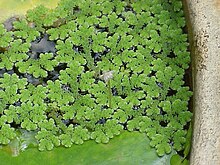Azolla
| Mosquito fern Temporal range: Maastrichtian-Holocene |
|
|---|---|
 |
|
| Azolla caroliniana | |
| Scientific classification | |
| Kingdom: | Plantae |
| Division: | Pteridophyta |
| Class: | Polypodiopsida / Pteridopsida (disputed) |
| Order: | Salviniales |
| Family: | Salviniaceae |
| Genus: |
Azolla Lam. |
| Type species | |
|
A. filiculoides |
|
| Species | |
|
See list below |
|
See list below
Azolla (mosquito fern, duckweed fern, fairy moss, water fern) is a genus of seven species of aquatic ferns in the family Salviniaceae. They are extremely reduced in form and specialized, looking nothing like other typical ferns but more resembling duckweed or some mosses.
Azolla caroliniana Willd. [ Poss. synon. of A. filiculoides ]
Azolla circinata Oltz & Hall
Azolla cristata Kaulf.
Azolla filiculoides Lam.
Azolla imbricata (Roxb. ex Griff.) Nakai
Azolla japonica Franch. & Sav. [ Poss. synon. of A. filiculoides ]
Azolla mexicana C.Presl
Azolla microphylla Kaulf.
Azolla nilotica Decne. ex Mett.
Azolla pinnata R.Br.
Azolla rubra R.Br. [ Poss. synon. of A. filiculoides ]
At least six extinct species are known from the fossil record:
Azolla is a highly productive plant. It doubles its biomass in 3–10 days, depending on conditions, and yield can reach 8–10 tonnes fresh matter/ha in Asian rice fields. 37.8 t fresh weight/ha (2.78 t DM/ha dry weight) has been reported for Azolla pinnata in India (Hasan et al., 2009).
Azolla filiculoidess (Red Azolla) is the only member of this genus and of the family Azollaceae in Tasmania. It is a very common native aquatic plant in Tasmania. It is particularly common on farm dams and other still water bodies. The plants are small (usually only a few cm across) and float, but can be very abundant and form large mats. The plants are typically red, and have very small water repellent leaves. Azolla floats on the surface of water by means of numerous, small, closely overlapping scale-like leaves, with their roots hanging in the water. They form a symbiotic relationship with the cyanobacterium Anabaena azollae, which fixes atmospheric nitrogen, giving the plant access to the essential nutrient. This has led to the plant being dubbed a "super-plant", as it can readily colonise areas of freshwater, and grow at great speed - doubling its biomass every two to three days. The only known limiting factor on its growth is phosphorus, another essential mineral. An abundance of phosphorus, due for example to eutrophication or chemical runoff, often leads to Azolla blooms.
...
Wikipedia
